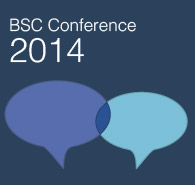BSC 2014: Eric Peper
by Siegfried Othmer | December 11th, 2014by Siegfried Othmer, PhD

E ric Peper entertained us with a discussion of just how much can be accomplished with attention to basic lifestyle issues such as diet, exercise, breathing, and posture. In a participatory session, the audience experienced directly the importance of posture in mood regulation and functional competence—even physical strength. Posture has a direct and prominent influence on cortisol and testosterone levels. Our fixation on computer screens and smartphones while looking downward leaves us with non-optimal posture and at risk of postural immobility syndrome. “We look down and curve our upper spine to read the tablet, crane our heads forward to read the screen, lift our shoulders, arms and hands up to the laptop keyboard to enter data, and we bend our heads down and squint to read the smartphone—all occurring without awareness.”
This happens to be the topic of a recent blog by Eric, which can be accessed here:
http://peperperspective.com/2014/11/12/adjust-your-world-to-fit-you-become-the-unreasonable-person/
A case example exemplifies the message of the talk: Eric worked with a college student who still suffered from several seizures a week despite being well-medicated. Inquiry into his lifestyle revealed that his eating habits left him at risk of episodic hypoglycemia. Posture was dreadful. It turns out that he had had an appendectomy, which may have changed his pattern of movement to protect an initially vulnerable and painful abdomen. No abdominal stretching meant no abdominal breathing, placing him at risk of shallow, rapid breathing. The combination of over-breathing and episodic hypoglycemia in a context of depression likely exacerbated his seizure risk.
And so it was. With the gradual acquisition of new habits of functioning, the seizure incidence declined to zero over a few weeks. Eric had met with him only a few times. The burden of compliance with new strictures was on the student. Eric triumphantly pointed out that this was surely a lot better than fifty sessions of SMR-training, and I would hasten to agree.
The behavioral management of epilepsy has a long and distinguished history, going back at least to the work of JoAnne Dahl in Sweden beginning in the eighties. The blinkered state of affairs within clinical neurology is starkly confirmed by Eric’s observation that the prescribing neurologist in the case he described had asked nothing about the various risk factors in the young man’s life—nothing about sleep, diet, or anything else. The pharmacological monoculture of medicine is to be lamented. Neurofeedback practice should not fall into the same pattern. Self-regulation is a multi-dimensional enterprise.
Eric showed a case example of a number of physiological tracking measures for one individual, and observed that the blood volume pulse, as measured via photoplethysmography, was highly variable. Such responsiveness makes it of great interest to us as a tracking measure for our neurofeedback training. One is seeing fluctuations in vasoconstriction, a sensitive indicator of autonomic state.





